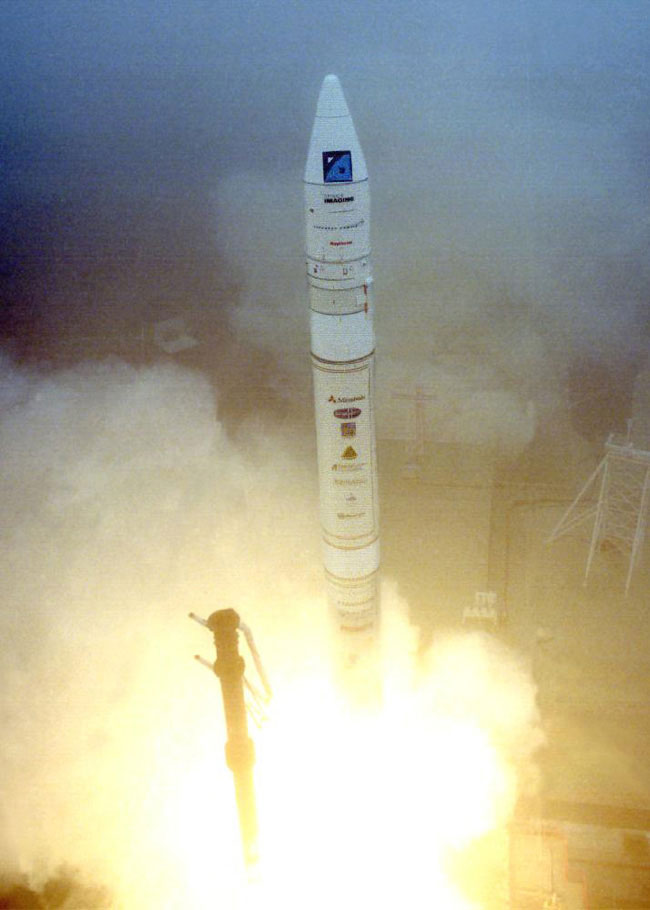
SAN FRANCISCO — Lockheed Martin Corp. plans to conduct the first rideshare flight of its Athena 2 rocket in September 2014 carrying a collection of satellites — built primarily by government customers — from Alaska’s Kodiak Launch Complex into low Earth orbit.
The rideshare service, which Lockheed Martin hopes to offer annually, is not designed to undercut the cost of sending a small satellite as a secondary payload on a larger rocket. Instead, it is designed primarily to attract government agencies seeking to fly satellites weighing between 50 and 180 kilograms to precise orbital locations.
Athena rockets derive their ability to place payloads into distinct orbital slots from precision-pointing technology company engineers developed while working on the Navy’s Fleet Ballistic Missile program. That technology enables the rocket to perform substantial maneuvering while on orbit. It could, for example, place four surveillance satellites into a single orbital plane to provide persistent coverage of an important target, said Gregory Kehrl, Athena mission manager for Denver-based Lockheed Martin Space Systems.
That capability to deploy constellations also may appeal to military agencies seeking to make space-based communications constellations more resilient, Robert Cleeve, president of Lockheed Martin Commercial Launch Services, said. “You can put up three geostationary satellites or a larger constellation of [low Earth orbit] satellites to provide global connectivity,”he said. “It turns out the larger constellation degrades much more gracefully and is more resilient.”
The new rideshare service also is designed to offer customers timely access to orbit. “None of the customers we are courting can afford an entire rocket,” Kehrl said. “So they are forced to be a secondary payload.” Because launch schedules revolve around a mission’s primary payload, any changes in the mission plan may result in delays or cancellation of secondary payload flights, Kehrl added.
Athena 2 rideshare flights will not feature a primary payload, but will be designed to accommodate a collection of 50- to 180-kilogram satellites. Remaining cargo capacity will be filled by cubesats, the miniature spacecraft that measure 10 centimeters on a side. Lockheed Martin has agreed to carry eight cubesats on each rideshare flight to support NASA’s Educational Launch of Nanosatellites, a program managed by NASA’s Kennedy Space Center in Florida that seeks to send cubesats as auxiliary payloads on space agency missions, Kehrl said.
Since announcing plans in 2010 to revive the Athena program, which conducted five successful missions between 1997 and 2001, Lockheed Martin officials have been meeting with potential customers to market the launch vehicle and working with vendors to acquire necessary components. Initially, program managers hoped to obtain enough commitments from small satellite customers to launch the first Athena 2 rideshare flight in September 2013. That flight is now scheduled to occur one year later, Kehrl said.
Customers who sign up for the planned rideshare service will pay only for their portion of the Athena launch cost. Lockheed Martin officials declined to discuss the price each customer would pay to launch a small satellite. The three-stage Athena 2, which can transport 1,712 kilograms to low Earth orbit, has an advertised price of $65 million.
When Lockheed Martin produced Athena rockets in the 1990s, United Technologies’ Chemical Systems Division built the upper stage. Since that motor is no longer in production, Lockheed Martin is equipping new Athena rockets with Castor 30 upper stages built by Minneapolis-based Alliant Techsystems (ATK). ATK developed the Castor 30, a commercial version of the Peacekeeper first stage, for Orbital’s medium-lift Antares rocket. ATK also plans to provide the Castor 120 for Athena’s first and second stages, the same motors used when Athena first flew.
As part of a strategic teaming agreement, Lockheed Martin will manage Athena missions, integrate payloads and oversee launches while ATK provides the vehicle’s propulsion, booster integration and launch site operations.
Lockheed Martin announced plans in March to use the Kodiak Launch Complex as its sole West Coast launch site for Athena 1 and Athena 2 rockets. Company officials also are analyzing the cost of launching larger Athena 3 rockets from Alaska and working with NASA to develop the capability to launch Athena 3 rockets from Kennedy Space Center.
“That’s exciting because it would allow us to lift a reasonably sized satellite to geosynchronous transfer orbit,” Cleeve said. An Athena 3 launched from Kennedy Space Center could, for example, send a satellite the size of Boeing’s all-electric 702 satellite to geosynchronous transfer orbit, he added. Regional satellite operators Asia Broadcast Satellite and Satmex announced plans in March to buy four Boeing 702SP — or “small platform” — electric propulsion spacecraft each weighing approximately 1,800 kilograms.
Lockheed Martin officials also are keeping close tabs on the Air Force Orbital Suborbital Program (OSP)-3. Through that program, Air Force officials are seeking performance and system design data on existing and emerging launch vehicles for future national security and civil space missions. The new entrant portion of the OSP-3 program stems from a pact the Defense Department, National Reconnaissance Office and NASA signed in October to enhance launch vehicle competition and to give government officials greater flexibility in choosing rockets for specific missions based on cost and risk.
The Air Force plans to issue a formal request for OSP-3 industry proposals in May, said LaGina Jackson, spokeswoman for the Air Force Space and Missile System Center in Los Angeles. According to an OSP-3 program plan published April 24, the Air Force is looking for launch vehicles for suborbital fights as well as orbital flights in two categories: rockets capable of lifting 181 to 1,810 kilograms to low Earth orbit and rockets capable of lifting 1,810 to 9,072 kilograms to low Earth orbit. Through the OSP-3 program, the Air Force plans to award multiple indefinite-delivery, indefinite-quantity contracts. Rocket builders who win those contracts will then be eligible to bid on specific launch missions.
Related
ncG1vNJzZmiroJawprrEsKpnm5%2BifK27wqSfnp2UYsGivsaeq6xlYmV%2BdXnArZ%2BeppFif26%2ByJ2crKCRp7JusMSbrK1n